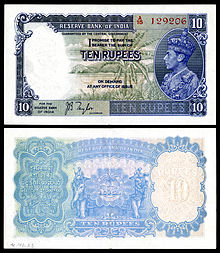RBI
Reserve Bank of India
भारतीय रिज़र्व बैंक HeadquartersMumbai, MaharashtraCoordinatesEstablished1 April 1935; 81 years agoGovernorUrjit PatelCurrencyIndian Rupee (₹)ReservesUS$363.00 billion[1][2]Bank rate6.25%[3]Interest on reserves4.00%(market determined)[4]Websitehttps://rbi.org.in/
HeadquartersMumbai, MaharashtraCoordinatesEstablished1 April 1935; 81 years agoGovernorUrjit PatelCurrencyIndian Rupee (₹)ReservesUS$363.00 billion[1][2]Bank rate6.25%[3]Interest on reserves4.00%(market determined)[4]Websitehttps://rbi.org.in/
The old RBI Building in Mumbai
The Reserve Bank of India (RBI, Hindi: भारतीय रिज़र्व बैंक) is India's central banking institution, which controls the monetary policy of theIndian rupee. It commenced its operations on 1 April 1935 during the British Rule in accordance with the provisions of the Reserve Bank of India Act, 1934.[5] The original share capital was divided into shares of 100 each fully paid, which were initially owned entirely by private shareholders.[6] Following India's independence on 15 August 1947, the RBI was nationalised on 1 January 1949.
The RBI plays an important part in the Development Strategy of the Government of India. It is a member bank of the Asian Clearing Union. The general superintendence and direction of the RBI is entrusted with the 21-member Central Board of Directors: theGovernor, 4 Deputy Governors, 2 Finance Ministry representatives, 10 government-nominated directors to represent important elements from India's economy, and 4 directors to represent local boards headquartered at Mumbai, Kolkata, Chennai and New Delhi. Each of these local boards consists of 5 members who represent regional interests, and the interests of co-operative and indigenous banks.
The bank is also active in promoting financial inclusion policy and is a leading member of the Alliance for Financial Inclusion (AFI).
The bank is often referred to by the nameMint Street.[7]
HistoryEdit
1935–1950Edit
Reserve Bank of India-10 Rupees (1938), first year of banknote issue.
The Reserve Bank of India was founded on 1 April 1935 to respond to economic troubles after the First World War.[8] The Reserve Bank of India was conceptualized based on the guidelines presented by the Central Legislative Assembly passed these guidelines as the RBI Act 1934.[9] RBI was conceptualized as per the guidelines, working style and outlook presented by Dr B R Ambedkar in his book. It was titled “The Problem of the Rupee – Its origin and its solution” and presented to the Hilton Young Commission. The bank was set up based on the recommendations of the 1926 Royal Commission on Indian Currency and Finance, also known as the Hilton–Young Commission.[10] The original choice for the seal of RBI was The East India CompanyDouble Mohur, with the sketch of the Lion and Palm Tree. However it was decided to replace the lion with the tiger, the national animal of India. The Preamble of the RBI describes its basic functions to regulate the issue of bank notes, keep reserves to secure monetary stability in India, and generally to operate the currency and credit system in the best interests of the country.[11] The Central Office of the RBI was established in Calcutta (now Kolkata), but was moved to Bombay (now Mumbai) in 1937. The RBI also acted as Burma's central bank, except during the years of the Japanese occupation of Burma (1942–45), until April 1947, even though Burma seceded from the Indian Union in 1937. After the Partition of India in 1947, the bank served as the central bank for Pakistan until June 1948 when the State Bank of Pakistancommenced operations. Though set up as a shareholders’ bank, the RBI has been fully owned by the Government of India since its nationalization in 1949.[12]
1950–1960Edit
In the 1950s, the Indian government, under its first Prime Minister Jawaharlal Nehru, developed a centrally planned economic policy that focused on the agricultural sector. The administration nationalized commercial banks[13] and established, based on the Banking Companies Act of 1949 (later called the Banking Regulation Act), a central bank regulation as part of the RBI. Furthermore, the central bank was ordered to support economic plan with loans.[14]
1960–1969Edit
As a result of bank crashes, the RBI was requested to establish and monitor a deposit insurance system. It should restore the trust in the national bank system and was initialized on 7 December 1961. The Indian government found funds to promote the economy and used the slogan "Developing Banking". The government of India restructured the national bank market and nationalized a lot of institutes. As a result, the RBI had to play the central part of control and support of this public banking sector.
1969–1985Edit
In 1969, the Indira Gandhi-headed government nationalized 14 major commercial banks. Upon Gandhi's return to in 1980, a further six banks were nationalized.[10] The regulation of the economy and especially the financial sector was reinforced by the Government of India in the 1970s and 1980s.[15] The central bank became the central player and increased its policies for a lot of tasks like interests, reserve ratio and visible deposits.[16] These measures aimed at better economic development and had a huge effect on the company policy of the institutes. The banks lent money in selected sectors, like agri-business and small trade companies.[17]
The branch was forced to establish two new offices in the country for every newly established office in a town.[18] The oil crisesin 1973 resulted in increasing inflation, and the RBI restricted monetary policy to reduce the effects.[19]
1985–1991Edit
A lot of committees analysed the Indian economy between 1985 and 1991. Their results had an effect on the RBI. The Board for Industrial and Financial Reconstruction, theIndira Gandhi Institute of Development Research and the Security & Exchange Board of India investigated the national economy as a whole, and the security and exchange board proposed better methods for more effective markets and the protection of investor interests. The Indian financial market was a leading example for so-called "financial repression" (Mackinnon and Shaw).[20] TheDiscount and Finance House of India began its operations on the monetary market in April 1988; the National Housing Bank, founded in July 1988, was forced to invest in the property market and a new financial law improved the versatility of direct deposit by more security measures and liberalisation.[21]
Visit the kavyesh gk world page





Comments
Post a Comment